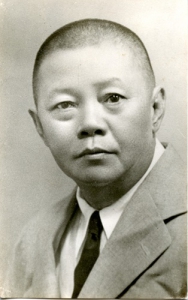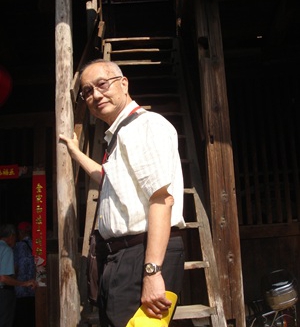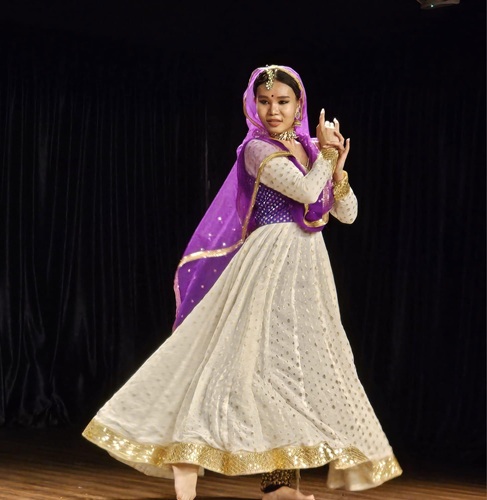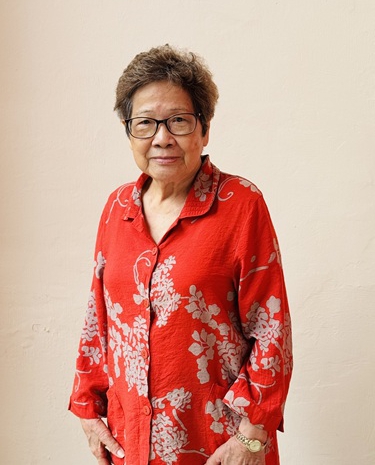子承父志振兴百年俱乐部
——先贤后裔陈庆力
文·莫美颜
图·吾庐俱乐部提
纳街(Club Street)街尾有一栋刷上白色的建筑物,典雅壮观。建筑外墙绘制了一幅很大的壁画,上面绘有陈延谦、邱国瓦、林文庆、李光前等先驱人物,本地华社百年史历历在目。眼前是成立于1905年,已有百多年历史的吾庐俱乐部(Goh Loo Club)。
除入门处的正匾—孙中山秘书陶文波书写的“吾庐”,俱乐部内还有多幅对联,包括:“吾家千里留星岛,庐舍万灯耀海滨”;清朝名士朱汝珍赠予陈延谦的匾额“吾亦爱吾庐”等墨宝,还有中国画大师沈其昭一幅以没骨法绘制的黑马和各类书画及老照片。会员还可在俱乐部内翻阅书籍、下围棋,书香气息满溢俱乐部。
力挽吾庐俱乐部颓风
吾庐俱乐部是战前新加坡最重要也最有势力的华人俱乐部之一。其会员曾支持孙中山领导的辛亥革命,二战时也曾积极筹款支援中国大陆的军队。上世纪的40年代到90年代是俱乐部最辉煌的年代。然而90年代后因管理不当,建筑物破败不堪,还爆出所收藏的部分名画被贱卖或不翼而飞的事件。
但2016年翻新后,俱乐部如重生的浴火凤凰,再次发挥其社会功能。俱乐部自2016年尾邀请电视艺人郭亮谈“那个下午”之后,平均每半年或一个月都办一次公开讲座,或由会员联合做东举办聚餐会,分享健康、时事、金融等方面的知识,俱乐部内一片生机勃勃。

已脱胎换骨的吾庐俱乐部
吾庐俱乐部的重获新生,有陈庆力(63岁,Tan Keng Leck)的努力和付出。
决心挽救吾庐俱乐部-1-300x225.jpg)
陈庆力(右)决心挽救吾庐俱乐部
陈庆力是吾庐俱乐部现任主席,他也是先贤陈延谦(Tan Ean Khiam,1881-1943)的孙子,陈笃山(Tan Tock San,1925-2008)的儿子。他为人低调谦卑,有人请他以文字介绍自己,他拖了好几天才简单地写了几行字:
陈庆力,福建同安人。祖辈移居新加坡。正业虽理,嗜好频多。佛道玄学,文武气功。三教九流,交游广阔。偶作诗词,也做义工。经商俾久,乃未见功。名片翰头,比一般多。幸有贤妻,四个子女,不劳操心,还算不错。
义工服务机构:延庆寺、陈延谦基金、吾庐俱乐部。
陈庆力出手拯救俱乐部,可说延续了其先辈服务社会的崇高精神,可他却轻描淡写地说:“当时的吾庐俱乐部没人管,情况非常糟糕,是重组和翻新的时候了。”
据知,早在2007年,陈庆力的父亲陈笃山就有重振俱乐部旗鼓的想法,但振兴工作还没来得及展开,他便于2008年与世长辞。三年后,即2010年,陈庆力毅然继承父亲的遗愿展开俱乐部的重振工作。
除和另外几名董事采取法律行动夺回吾庐俱乐部房地产的控制权,并以董事身份抵押有关产业,陈庆力还与吾庐董事李金拔的孙子李明正联手重振吾庐俱乐部,并向银行贷款400万元展开大规模修复工程。2016年翻修后的俱乐部重现建筑原有的风貌,还获得当年市区重建局与发展局颁发的旧建筑修复大奖。
陈庆力说:“俱乐部的事,只要有人做就好,谁做都无所谓。”他自嘲自己是个懒散的人,担任吾庐俱乐部主席只是过渡时期的事,希望接下来有人接手这项任务。
祖父陈延谦是著名银行家
陈庆力非常佩服祖父和父亲。他的祖父陈延谦15岁就辍学了,没受过高深教育却能在商场上大展鸿图,还成为知名的银行家。华侨银行就是他和林文庆、林义顺、陈先恭等人合力创办的,他也兼营树胶业。“要不是他的头脑特别好,又怎能办到?”
陈延谦是华社杰出的领导人之一,对社会的贡献不小。1919年到1930年他任新加坡中华总商会董事;1926年保赤宫陈氏宗祠重修时,任正总理;1929年到1942年任吾庐俱乐部总理,是吾庐俱乐部主要的领导人之一,吾庐会所是他当年与邱国瓦主导购置的;1931年他发起创立同安会馆,并担任首届总理;1937年至1942年出任海峡殖民地华人参事局委员及保良局委员。

陈延谦是知名银行家
孙中山在南洋进行革命活动的重要基地晚晴园,在革命后易主。1937年原同盟会会员等六人合资购回晚晴园,并把它交给中华总商会管理。这六人除李光前、李振殿、周瑞献、李俊承、杨吉兆,还有一位就是陈延谦。
孙中山在南洋进行革命活动的重要基地晚晴园,在革命后易主。1937年原同盟会会员等六人合资购回晚晴园,并把它交给中华总商会管理。这六人除李光前、李振殿、周瑞献、李俊承、杨吉兆,还有一位就是陈延谦。
陈延谦也支持本地的教育事业,曾任多所华校董事长或董事,上世纪20年代还担任华侨中学总理多年。他对家乡也多有关注,曾多次捐钱在厦门进行铁路建设及兴办学校,一度是厦门大学董事。
陈延谦商余醉心诗文,他的止园是南下中国文人名流吟诗抒怀雅聚的地方。他本人的诗作都收集在《止园集》中,内容有他对经济的分析、人生的感慨和旅游荷兰时的感想。陈庆力说:“祖父的诗文,不全用白话书写而且通篇没有标点符号,不易阅读,我还没读完,也还没完全读懂。”陈庆力虽不说,相信他从祖父的诗文中汲取了不少滋养。
此外,陈延谦还独资开发东海岸路旁一片荒地,1927年起在那里兴建住屋、店屋,历时6年把它发展成一个聚落,这就是今日仍然保留原貌的延谦坊(Ean Kiam Place)。
陈延谦还遗爱后人,留下遗嘱要在他故去后将其遗产的10%捐作慈善。陈延谦辞世后,其子就成立陈延谦基金,该基金于1956年开始运作,延谦坊的产业收益就是基金的主要资金来源,基金80%用作慈善和帮助需要的弱势人群。受益的组织和团体包括:全国肾脏基金、同济医院、新加坡中华总商会、李光耀奖学金基金等,并与国立大学医学系合作颁发奖学金,为社会培养优秀人才。
父亲陈笃山热心服务社会
陈延谦有八子三女,陈笃山排行第三,他在父亲逝世后继承父业,1963年加入银行界,担任新加坡银行董事、常务董事、副主席和主席;1969年出任华侨银行董事,后兼任董事部常务委员会委员。

陈笃山继承父业,后也成为银行家
陈笃山非常热心公益和服务社会,有乃父之风,除慷慨赞助社会公益活动,还在多个组织担任要职,这包括:蒙巴登区公民咨询委员会、市东区公民咨询委员会、蒙巴登民众联络所管委会、中华总商会、陈嘉庚奖学金基金信托委员会、新加坡艺术理事会、新加坡防痨协会、同济医院、善济医社、保赤宫陈氏宗祠、福建会馆、同安会馆、义安工艺学院理事、新加坡初级学院委员会建校小组、德明中学咨询委员会、中华女子中学、华侨中学、南洋女中、新日文化协会等,服务范围跨越社区、经济、艺术、医疗保健、教育与社团等领域。他于1994年获新加坡总统授予太平局绅荣衔。
身为长男的陈庆力记得:“父亲非常忙碌,每晚都要应酬,感觉他好像有用不完的精力,我根本难望其项脊。与父亲相比,我现在所做的根本不足挂齿。
母亲林斐为人类学家林惠祥之女
陈笃山娶林斐(1926-2011)为妻。林斐出生于中国厦门,中英兼通,早年曾服务教育界,也在报社当过翻译员,是本地少见的女指画家,师承吴在炎,画风清秀隽永。她去世七年后,即2018年长子陈庆力为她举办“一片天真—林斐指画纪念展”展出38幅遗作,收益部分交由陈延谦基金托管。
陈庆力说:“妈妈是父亲的贤内助,父亲的演讲稿都是母亲写的,父亲公司每年印制的贺年卡也都是母亲的指画作品。母亲为人斯文,平易近人,也不随便花钱。”
林斐来自书香之家,是人类学家林惠祥(1901-1958)的长女。林惠祥是中国人类学和人类文化学研究之父。他幼时迁居台湾,日战爆发后举家到槟城避难,曾任槟城钟灵中学校长,战后南下新加坡,1947年回返厦门大学任教,从事人类学和考古研究工作,后在厦门大学成立人类学博物馆。
这次笔者是在菲立街(Phillip Street)一栋大厦的办公室访问陈庆力。大厦为陈笃山所建,命名陈延谦大厦(Tan Ean Kiam Building)。
陈庆力的生活很忙碌,经常出国公干。问他在哪个领域发展,他轻描淡写地说:“做一点投资,不过不是很成功。”
陈庆力有多方面的兴趣,有关宗教、哲学、身心灵、励志和易经等他都有涉及,年轻时还想过拍电影。“现在年纪大了,拍不了电影,拍动漫还可以。”目前他正在着手制作《悲悯大地》(Land of Mercy)动漫。《悲悯大地》是中国作家范稳继《水乳大地》之后推出的第二部描写藏区宗教、历史及民族文化的长篇小说。小说的英译版本已由陈庆力所经营的仁钦宝典出版社出版。此外,陈庆力也为歌曲填词,制作过一张佛教音乐CD《一念莲华》。
陈庆力多次赞助俱乐部举办的文化讲座。他是第一场文化讲座的赞助人,那次会上他没自我介绍,而是为一位患病老人筹款。这种乐于助人的精神,颇有家族遗风。
陈庆力的弟弟陈庆加,姐姐陈美琪,妹妹陈相如和陈真如一样热心慈善。他们很低调,但都心系社会,默默用慈善爱心表达着对社会的关怀。
(作者为本刊特约记者)
Recollections of a father’s dedication to a Club – Interview with Tan Keng Leck
At one end of Club Street in Chinatown stands a whitewashed building – traditional yet dignified. On the side of an external wall is a mural painted with the likes of Tan Ean Kiam, Lim Boon Keng and Lee Kong Chian, early notable Chinese personalities. This is the historical Goh Loo Club, founded in 1905. Upon the main entrance one sees the imposing calligraphy of “GOH LOO” written by Tao Wen Bo, the secretary to Dr Sun Yat Sen. Once inside the main hall are many couplets extolling the name of Goh Loo. In particular, a masterful calligraphy piece by Qing Dynasty scholar Zhu Ru Zheng dedicated to Tan Ean Kiam which reads fervently “We all love our Goh Loo”. Further in, a brush drawing by internationally renowned artist Shen Qi Zhao of a spirited black horse. In this peaceful environment, members enjoy many quiet recreation.
Revival of Goh Loo Club
In the pre-War period, Goh Loo club was one of the most prominent Chinese club. Its members were generous donators to Sun Yat Sen’s 1911 Revolution. During the war against Japan the club raised substantial funds for the Mainland’s war efforts. The period from the 1940’s till 1990’s was the Club’s prime period. Towards the ending of the 90’s, the club’s management fell into severe neglect. It was not until 2016, like a phoenix arising from the ashes that Goh Loo began a series of cultural and social activities which revived members interest. The vigorous rejuvenation of the Club was the effort of Tan Keng Leck.
Tan Keng Leck is the present chairman of Goh Loo Club. He is the grandson of Tan Ean Kiam (1881 – 1943) and son of Tan Tock San (1925 – 2008). A man of humble demeanour, he is self-deprecating in spite of his many worthy esteemed contributions to many social organisations. His work in the revival of Goh Loo Club was exemplary of his keen public spirit, and his dedicated desire to fulfil his father’s wish in reviving the Club. In 2010 he started his mission accordingly. After settling the legalities of the property of the Club’s premises, he and Mr Li Ming Zheng jointly made their plans. After securing a loan of $4million from banks, the rebuilding works began in earnest. In 2016 the renovation was completed. It was such a wonder of architectural accomplishment that it received the award from the Urban Redevelopment Authority’s Architectural Heritage Award that year.
Grandfather Tan Ean Kiam – a renowned banker
Tan Keng Leck has a great admiration for his grandfather and father. Grandfather Tan Ean Kiam did not have a very high education having left school at the age of 15. Inspite of this, his great entrepreneurial spirit led him to become a renowned banker. Oversea Chinese Bank was founded by him together with Lim Boon Keng, Lim Nee Soon, SK Tan and others. At the same time he developed an extensive rubber business.
Tan Ean Kiam was a leading member of several organisations, amongst which was the Singapore Chinese Chamber of Commerce, which he served from 1919 to 1930; founded the Tung An District Guild in 1931; from 1937 to 1942 appointed to the Straits Settlements Chinese Affairs Bureau and the Chinese Protectorate. In the Goh Loo Club, he served as Chairman from 1929 to 1942, during which together with Chew Kok Wah, they bought the club.
Wan Qing Yuan is a revered centre of Dr Sun Yat Sen’s revolutionary endeavours while in Singapore. In 1937, Tan Ean Kiam together with another five members of the Tong Meng Hui, viz Lee Kong Chian, Lee Chin Tian, Chew Hean Swee, Lee Chor Seng and Yeo Kiat Tiow, bought the building and later handed over to the Singapore Chinese Chamber of Commerce.
One of Tan Ean Kiam’s favourite hobby is composing Chinese poems. His poetry has been compiled into a volume called the “Zhi Yuan collection”. Tan Keng Leck admits that up till now, he is unable to completely understand and interpret his grandfather’s poetry, but it is believed that he has derived lots of wisdom from the diverse topics which those poems covered.
In an area off the East Coast Road there is a place called Ean Kiam Place. Originally an unused piece of land which Tan Ean Kiam bought and then developed. Most of the original buildings still stand. Today, part of the revenue from this development forms the funds for the Tan Ean Kiam Foundation, whose beneficiaries include National Kidney Foundation, Thong Chai Hospital and a scholarship for the Medical Faculty in the National University Hospital.
Father Tan Tock San’s public service
Tan Tock San (1925 – 2008), father of Tan Keng Leck, is the third son of Tan Ean Kiam. He became a banker in 1963; becoming a director in Overseas Chinese Bank in 1969. Like his father, he is extremely active in many public institutions and social organisations. The medical institutions he supported included Thong Chai Medical Institute, Sian Chay Medical Institute and SATA; educational institutions included Ngee Ann Polytechnic, National Arts Council, Dunman Secondary School Board, Chong Hwa Girls High School, Hwa Chong Institution, Nanyang Girls School and Tan Kah Kee Scholarship Committee amongst many others. He was active in grassroots organisations like Mountbatten Citizens Consultative Committee and Mountbatten Community Centre Committee. In 1994 he was awarded a Justice of the Peace by the Singapore President.
Tan Tock San married Lim Fei (1926 – 2011). She was born in XiaMen , China and the eldest daughter of Lin Hui Xiang (1901 – 1958) an anthropology professor from Taiwan. Lim Fei was bilingual in Chinese and English, worked as an educator and also as a translator.
The author conducted the interview for this article with Tan Keng Leck at his office at the Tan Ean Kiam Building in Philip Street. Tan Keng Leck, together with his brother and three sisters are equally modest and humble. But all equally dedicated to philanthropy and public service.
(Translated by Kwan Yue Keng)






